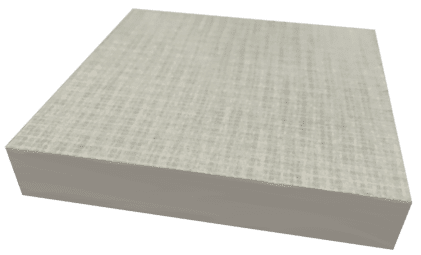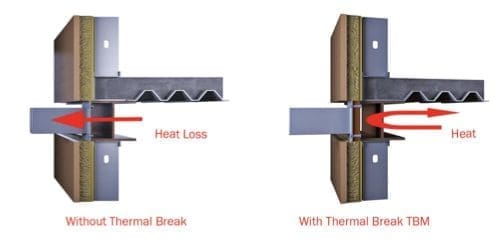
Thermal Break Material 2 (TBM-2) (non-combustible) (Thin)
Thermal Break Material™ TBM-2 is a reinforced, composite manufactured using non-combustible materials. Compatible with all field applied air barriers, sealants and flashings.
- Reduces conductive heat loss due to thermal bridging
- Keeps surface temps above dew point to prevent condensation risk
- Conducts heat:
-
- 1,000 times less than aluminum
- 270 times less than steel
- 80 times less than stainless steel
-
- Uses:
-
- Cladding Connections
- Sunshade brackets
- Roof posts, anchors
- Roof edge
- Lintels
- Shelf angles
- Curtain wall plates, anchors
-
- Available sizes:
-
- 1/4″ & 1/2″ (order below)
- 3/4″, 1″ & 2″ (click HERE to order)
-
Use TBM-2 in cladding attachment and light load moment connections.
The purpose of a thermal break is to reduce the impact of thermal bridging by preventing conductive heat flow through the building thermal envelope. Thermal breaks also help keep surface temperatures above the dew point within the thermal envelope. This eliminates potential condensation risk.
Thermal break material TM (TBM-2) conducts heat 1,000 times less than aluminum, 270 times less than steel, and 80 times less than stainless steel. Conduction is a function of thickness and temperature difference for any material, so the thickness of a thermal break material should be carefully considered.
As non-combustible, it is not necessary to conduct NFPA 285 or ASTM E119 fire rating tests (when required) when TBM-2 is incorporated in wall or roof assemblies.
High-performance building material
| Insulation Type |
Rigid Board |
|---|---|
| Air Tightness |
Permeable |
| Flammable |
No |
| Moisture Sensitive |
No |
| Vapor Permeability |
Class 4 – Permeable |
| R-Value Per Inch |
0.7 |
| Certifications |
LEED Platinum ,Red List Free (ILFI) |
| Compressive Strength (PSI) |
3,000 psi |
| Flame Spread |
<75 |
| Smoke Index |
<450 |
| Brand |
Thermal Bridging Solutions |
| Liftgate Needed |
No ,Yes |
| Thickness |
1/4" ,2" |

Thermal Break Material 1 (TBM-1)

Thermal Break Material 2 (TBM-2) (non-combustible) (Thick)

Thermoblock
$23.60 – $80.30
Thermal Break Material 3 (TBM-3) (non-combustible)

COMPACFOAM
$125.00 – $500.00Related products

Blaugelb – Insulation Panel MultiPro EPS
$55.46 – $231.10
PARTEL – ALMA VERT 180
$319.00 – $469.00
Rockwool AFB
$86.86
PARTEL – ALMA VERT 115
$177.70 – $281.90
Rockwool Comfort Batt R15
$78.44 – $78.87



